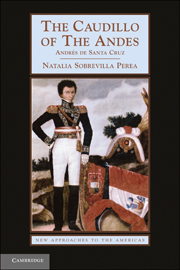Book contents
- Frontmatter
- Contents
- List of Maps and Illustrations
- Timeline for Santa Cruz
- Acknowledgments
- Introduction
- 1 Early Years at the Twilight of the Colonial Period
- 2 Great Marshall of Zepita
- 3 The Creation of Bolivia
- 4 The Genesis of the Peru-Bolivia Confederation
- 5 The Rise and Fall of the Peru-Bolivia Confederation
- 6 Defeat and Exile
- Epilogue: The Long-Term Consequences of the Fall of the Confederation
- Bibliography
- Index
5 - The Rise and Fall of the Peru-Bolivia Confederation
Published online by Cambridge University Press: 05 June 2012
- Frontmatter
- Contents
- List of Maps and Illustrations
- Timeline for Santa Cruz
- Acknowledgments
- Introduction
- 1 Early Years at the Twilight of the Colonial Period
- 2 Great Marshall of Zepita
- 3 The Creation of Bolivia
- 4 The Genesis of the Peru-Bolivia Confederation
- 5 The Rise and Fall of the Peru-Bolivia Confederation
- 6 Defeat and Exile
- Epilogue: The Long-Term Consequences of the Fall of the Confederation
- Bibliography
- Index
Summary
The union of Peru and Bolivia had been a long-held desire for many people with divided loyalties, such as Santa Cruz. Since independence, there had been a vocal constituency advocating both federation and political union. The southern provinces, separated by the creation of the Viceroyalty of the Río de la Plata in 1776, were reunited between 1810 and 1825 when the armies raised in southern Peru intervened to prevent the Junta of Buenos Aires from taking control of the Audiencia of Charcas. In colonial times they had belonged to different administrative entities for only thirty-four years. During the wars of independence, they were brought back together for fifteen years, and when the Confederation came into being, only a decade had elapsed since they had become separate republics. For many, the union of Peru and Bolivia was no more than a return to a comfortable status quo ante. Arequipa, Cuzco, Tacna, Puno, and La Paz remained the provinces historically most committed to the union, whereas those who had opposed it continued to view it with distrust. This chapter explores the process by which the Confederation came into being as well as the sources of its support. It also examines the difficulties the Confederation encountered and seeks to understand the opposition to it.
The union was never universally popular, but in spite of this Santa Cruz was able to silence the opposition in Bolivia and obtain the support he needed.
- Type
- Chapter
- Information
- The Caudillo of the AndesAndrés de Santa Cruz, pp. 147 - 183Publisher: Cambridge University PressPrint publication year: 2011



